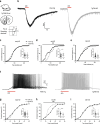Enhanced prefrontal nicotinic signaling as evidence of active compensation in Alzheimer's disease models
- PMID: 39623428
- PMCID: PMC11613856
- DOI: 10.1186/s40035-024-00452-7
Enhanced prefrontal nicotinic signaling as evidence of active compensation in Alzheimer's disease models
Abstract
Background: Cognitive reserve allows for resilience to neuropathology, potentially through active compensation. Here, we examine ex vivo electrophysiological evidence for active compensation in Alzheimer's disease (AD) focusing on the cholinergic innervation of layer 6 in prefrontal cortex. Cholinergic pathways are vulnerable to neuropathology in AD and its preclinical models, and their modulation of deep layer prefrontal cortex is essential for attention and executive function.
Methods: We functionally interrogated cholinergic modulation of prefrontal layer 6 pyramidal neurons in two preclinical models: a compound transgenic AD mouse model that permits optogenetically-triggered release of endogenous acetylcholine and a transgenic AD rat model that closely recapitulates the human trajectory of AD. We then tested the impact of therapeutic interventions to further amplify the compensated responses and preserve the typical kinetic profile of cholinergic signaling.
Results: In two AD models, we found potentially compensatory upregulation of functional cholinergic responses above non-transgenic controls after onset of pathology. To identify the locus of this enhanced cholinergic signal, we dissected key pre- and post-synaptic components with pharmacological strategies. We identified a significant and selective increase in post-synaptic nicotinic receptor signalling on prefrontal cortical neurons. To probe the additional impact of therapeutic intervention on the adapted circuit, we tested cholinergic and nicotinic-selective pro-cognitive treatments. Inhibition of acetylcholinesterase further enhanced endogenous cholinergic responses but greatly distorted their kinetics. Positive allosteric modulation of nicotinic receptors, by contrast, enhanced endogenous cholinergic responses and retained their rapid kinetics.
Conclusions: We demonstrate that functional nicotinic upregulation occurs within the prefrontal cortex in two AD models. Promisingly, this nicotinic signal can be further enhanced while preserving its rapid kinetic signature. Taken together, our work suggests that compensatory mechanisms are active within the prefrontal cortex that can be harnessed by nicotinic receptor positive allosteric modulation, highlighting a new direction for cognitive treatment in AD neuropathology.
Keywords: Acetylcholine; Acetylcholinesterase inhibitor; Alzheimer’s disease; Cognitive reserve; Compensation; Electrophysiology; Nicotinic receptors; Optogenetics; Prefrontal cortex.
© 2024. The Author(s).
Conflict of interest statement
Declarations. Ethical approval: This manuscript contains animal research that was approved by the Faculty of Medicine Animal Care Committee at the University of Toronto in accordance with the guidelines of the Canadian Council on Animal Care (protocols #20011621, #20011658, #20011796). This work was conducted under the appropriate Material Transfer Authorizations. Competing interests: The authors have no conflicts or competing interests to declare.
Figures





References
-
- Valenzuela MJ, Sachdev P. Brain reserve and dementia: a systematic review. Psychol Med. 2006;36:441–54. - PubMed
-
- Stern Y, Gurland B, Tatemichi TK, Tang MX, Wilder D, Mayeux R. Influence of education and occupation on the incidence of Alzheimer’s disease. JAMA. 1994;271:1004–10. - PubMed
-
- Stern Y, Alexander GE, Prohovnik I, Mayeux R. Inverse relationship between education and parietotemporal perfusion deficit in Alzheimer’s disease. Ann Neurol. 1992;32:371–5. - PubMed
Publication types
MeSH terms
Substances
Grants and funding
LinkOut - more resources
Full Text Sources
Medical

